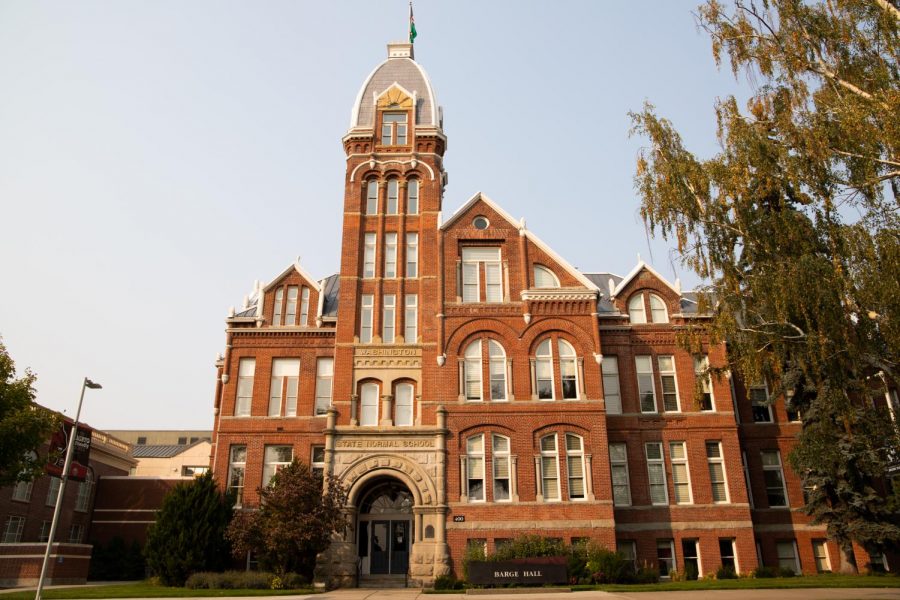CWU announces layoffs, outlines budget shortfall
October 5, 2020
Citing a decline in students enrolled and living on campus as well as a challenging financial outlook, CWU announced 56 layoffs on Sept. 30 that will impact 48 employees tied to residential services.
Soon after the announcement, Director of Human Resources Staci Sleigh-Layman joined President James L. Gaudino, Vice President of Business and Financial Affairs Joel Klucking and Vice President of Enrollment Management Josh Hibbard on a Zoom call to discuss the layoffs as well as the financial outlook of the university.
The layoffs will occur in five departments: housing, dining services, facilities, computing and supervision. Layoffs in supervision occur when a group of employees overseen by a supervisor is laid off and that supervisor no longer has employees working underneath them.
In addition to the 56 layoffs, CWU has also eliminated 140 open positions since spring 2020 as the school grapples with how to deal with a projected $8.5 million loss in enterprise funding. Before the pandemic, the school projected a net positive of $3.5 million in enterprise funding.
“That is really a terrible outcome for the enterprise funds. It represents two and a half to three years’ worth of results. Money that has been put in the bank to improve housing stock that we will not be able to do,” Klucking said. “We can sustain that for maybe one year, but not more than one year.”
The layoffs are the result of a combination of lost revenue as well as fewer students and employees living, working and attending on-campus classes. Klucking said a drop in 600 enrolled students will cost the school about $2.5 million in tuition over the course of the year, while the 60% dorm vacancy rate means a loss of $28 million compared to a typical year.
“The impact of the pandemic has obviously been substantial,” Klucking said.
And while CWU had a record number of applicants and the decrease in enrollment met projections, Klucking said “strong enrollment helps for sure, but it doesn’t solve everything.”
The 5% decrease in enrollment would impact all “fee-funded areas across the university,” Klucking said.
As a result of the pandemic, CWU plans to spend a large amount of its reserve money.
“We’re going to dip very deeply into our reserves, and I don’t see any other options,” Klucking said.
Klucking said CWU has also been told to prepare for a $10 million reduction, roughly 15%, in state funding in the upcoming session, although that decision hasn’t been finalized. Klucking said Washington is forecasting a $4.5 billion deficit over the next four years. This $4.5 billion budget deficit is an improvement over an $8 billion deficit the state had previously forecasted.
“We don’t necessarily know what the state is going to do, and we will find out when the session convenes in January,” Klucking said.
While layoffs were announced on Sept. 30, the impacted employees will not be notified until Oct. 8, and their last day of employment will be Nov. 6.
Gaudino said the layoffs marked “truly a sad day” at the university, and that any potential future layoffs would be heavily dependent on student enrollment.
“Our methodology was to look at where the work need has been reduced or in some cases eliminated and eliminate those positions,” Gaudino said.
If an outbreak were to occur on campus and the dorms closed again, similar to spring 2021, Sleigh-Layman said more jobs on campus could be in jeopardy.
“In many ways, those residential students are job security for many other employees at CWU,” Sleigh-Layman said.
In response to several audience questions regarding CWU’s decision to announce layoffs and the impacted departments over a week before impacted employees would be notified, Sleigh-Layman said the university tried to balance “transparency with anxiety” in the decision.
And while the notification would increase anxiety for some, Sleigh-Layman said she hoped it would lessen the anxiety that some employees felt.
“I was a proponent of being as transparent as could be,” Sleigh-Layman said. “We struggled a lot as to whether to give you the details of the layoffs that are coming.”
Gaudino also said since the decision on layoffs had been made, he wanted to ensure people heard the news from the university instead of other means.
Gaudino addressed a question regarding renovations to CWU’s presidential residence and said the work involved new carpeting and blinds and was akin to work done in between long term tenants of an apartment. Gaudino did not address several audience questions regarding his salary during the session.
“I didn’t want [Gaudino] in a position to have to answer those questions,” Sleigh-Layman said.



Marion Eastman • Oct 7, 2020 at 10:12 am
Are they cutting the salaries of the top administrators and professors ?
Paula McMinn • Oct 6, 2020 at 9:43 am
If they hadn’t squandered money on jet planes etc maybe a few more people would have jobs. They could also cut their own pay to save some of those jobs but this is the era of Trump; every man for himself. And while they were constructing all those new buildings there was not even a head nod towards renewable energy and no parking lot has a charger for an electric car. They call themselves an institute of higher learning, but they do not act like one. And as a citizen of this county, I think it was reckless to bring back students and open local schools. The virus is spiking all over the US including the White House. Thanks CWU for spiking our county COVID numbers. AND NOW CWU wants us to feed their students from our local food bank after laying off 56 workers. Give us covid, lay off workers and have us feed your students from our small town food bank. Institute of higher learning, indeed. Gaudino needs to answer a lot of questions.